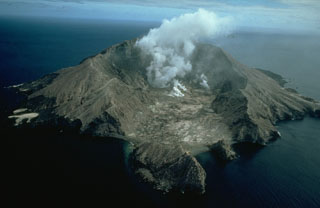Report on Whakaari/White Island (New Zealand) — 22 January-28 January 2025
Smithsonian Institution / US Geological Survey
Weekly Volcanic Activity Report, 22 January-28 January 2025
Managing Editor: Sally Sennert.
Please cite this report as:
Global Volcanism Program, 2025. Report on Whakaari/White Island (New Zealand) (Sennert, S, ed.). Weekly Volcanic Activity Report, 22 January-28 January 2025. Smithsonian Institution and US Geological Survey.
Whakaari/White Island
New Zealand
37.52°S, 177.18°E; summit elev. 294 m
All times are local (unless otherwise noted)
On 28 January GeoNet reported that emissions from Whakaari/White Island during the previous few weeks were characterized as weak-to-moderate gas-and-steam plumes that frequently contained minor amounts of ash. The plumes were visible in images from satellite and webcams (at Whakatane and Te Kaha), and during clearer weather conditions a larger plume was occasionally visible from the Bay of Plenty. The New Zealand Met Service also detected ash in the plumes using satellite images on some of the days. Ash was not visible in emissions during a midday observation overflight on 14 January, but during an overflight to measure volcanic gases later that afternoon, ash was visible in the emissions; sulfur dioxide gas flux was higher compared to periods of lower volcanic activity. A minor event where ash was visible in the plume was recorded in webcam images at 0710 on 27 January. The activity was consistent with moderate-to-heightened levels of unrest, therefore the Volcanic Alert Level remained at 2 (on a scale of 0-5). The Aviation Color Code remained at Orange (the second highest level on a four-color scale) due to the presence of ash in the emissions. GeoNet stated that the Alert Levels were reflective of the current level of activity, but there was uncertainty due to the current lack of consistent, usable, real-time monitoring data; GeoNet relies on remote cameras and satellite images to monitor Whakaari.
Geological Summary. The uninhabited Whakaari/White Island is the 2 x 2.4 km emergent summit of a 16 x 18 km submarine volcano in the Bay of Plenty about 50 km offshore of North Island. The island consists of two overlapping andesitic-to-dacitic stratovolcanoes. The SE side of the crater is open at sea level, with the recent activity centered about 1 km from the shore close to the rear crater wall. Volckner Rocks, sea stacks that are remnants of a lava dome, lie 5 km NW. Descriptions of volcanism since 1826 have included intermittent moderate phreatic, phreatomagmatic, and Strombolian eruptions; activity there also forms a prominent part of Maori legends. The formation of many new vents during the 19th and 20th centuries caused rapid changes in crater floor topography. Collapse of the crater wall in 1914 produced a debris avalanche that buried buildings and workers at a sulfur-mining project. Explosive activity in December 2019 took place while tourists were present, resulting in many fatalities. The official government name Whakaari/White Island is a combination of the full Maori name of Te Puia o Whakaari ("The Dramatic Volcano") and White Island (referencing the constant steam plume) given by Captain James Cook in 1769.
Source: GeoNet

